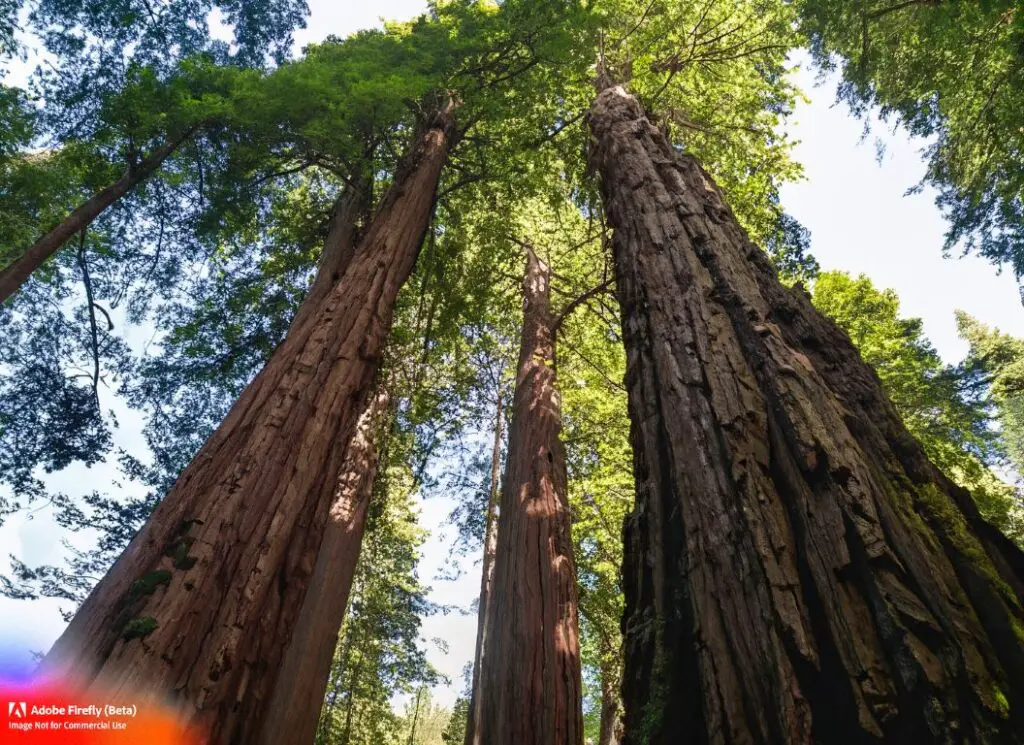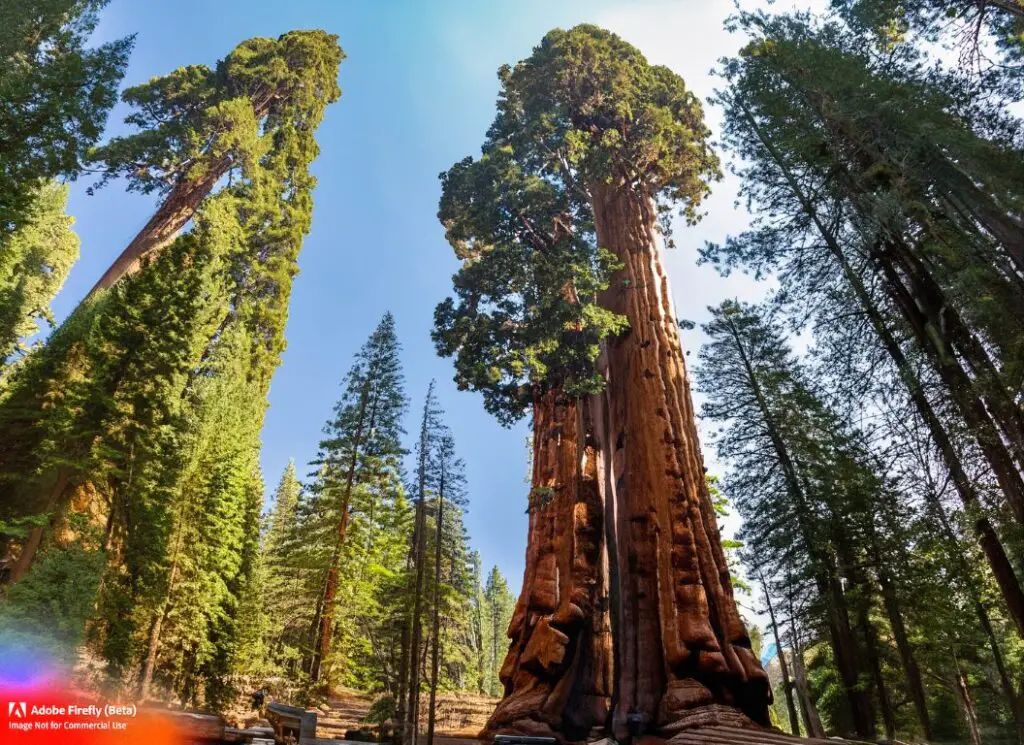
The tallest tree species in the world is the Sequoia sempervirens, commonly known as the Coastal Redwood. These are naturally found along the Pacific Coast of America and can grow to around 380ft in height and 15ft in trunk diameter. The tallest living Redwood, known as ‘Hyperion’, measures 380.1ft.
In this article, I will give some general information about Coastal Redwoods. Then, I’ll cover in detail what makes them so big. I’ll finish by outlining the difference between them and Giant Sequoias.

Coastal Redwoods – The Tallest Trees
The Sequoia sempervirens, or Coastal Redwood, is the tallest species of tree in the world. Coastal Redwoods can grow up to 380 ft tall and almost 30ft in diameter.
Coastal Redwoods are native to the Pacific Coast. Specifically Southern Oregon down to Central California. As the name suggests, Coastal Redwood grows no more than 50 miles inland. The coast provides the best climate for Redwoods to grow; dry summers and wet winters.
So What Makes Coastal Redwoods So Tall?
Coastal Redwoods get so tall because they are excellent at absorbing water. The more water a tree can drink, the taller it will grow. And Redwoods get A LOT of water.
During photosynthesis, trees use sunlight to turn CO2 and water into food. More water = more food
Redwoods get plenty of water throughout winter (50-100 inches) in their natural habitat. But the fog in the Summer is what really helps these trees. The fog helps by providing two things.
- Water
- Fertilizer
Water
Redwoods can collect moisture from the fog. This moisture collects on the needles and limbs and then drops to the forest floor. The tree’s root system then absorbs the water from the ground.
Unlike other trees, Redwoods can also absorb water through their canopy. So, the tree absorbs moisture through the air and the ground. Incredible!
Fertilizer
The fog is a good source of nitrogen, which is essential in protein formation. And protein is found in the tissue of most living things. So, the fog is delivering fertilizer to the Redwoods too.
To summarize, Redwoods get a constant supply of water throughout the year. Not only that, but they get a large amount of fertilizer too. The water and fertilizer are the perfect combinations to supercharge the Redwood’s growth.
The Tallest Tree of the Tallest Species
The title of the tallest tree in the world goes to a Coastal Redwood named Hyperion. Hyperion is 380.1 ft tall and lives in the Redwood National and State Parks. Hyperion’s exact location is unknown to protect the tree.
Interestingly, the Redwood National and State Parks also contain the second and third tallest trees globally. These trees are all Coastal Redwoods. It shows how much of an impact the climate can make on the growth of a tree.
Some experts say Hyperion could have been taller. When the tree was much smaller, it looked like wildlife topped it, stunting some of its growth. You might have even made some poor cuts to your tree, hindering its potential. Don’t worry; all hope isn’t lost.

Coastal Redwood vs. Giant Sequoia
Many people believe that the Giant Sequoia tree is the tallest, but these trees only grow to around 250 ft high. What makes these Sequoias, so giant is their diameter. Giant Sequoias have a whopping diameter of 30 ft!
The main difference lies here: The Coastal Redwood is the tallest tree species globally. But, on the other hand, the Giant Sequoia is the largest species by volume.
The biggest Giant Sequoia in the world is named General Sherman. General Sherman stands 275 ft tall, with a diameter of 36 ft. This makes the volume of General Sherman’s trunk 52,500 cu ft. Compare this to Hyperion, which has a trunk diameter of only 18,600 cu ft.
Some Other Differences Between the Two Giants…
Though these two trees look pretty similar, there are a few differences between the two. Let’s take a look.
Genera
These two trees both come from the same family, but they aren’t in the same genus. The family they originate from is Cupressaceae.
| Tree | Family | Genus | Species |
|---|---|---|---|
| Coastal Redwood | Cupressaceae | Sequoia | sempervirens |
| Giant Sequoia | Cupressaceae | Sequoiadendron | giganteum |
The Coastal Redwood is the only living species of the genus Sequoia
Bark
Both trees have thick bark that protects them from fire. However, the bark of the Giant Sequoia is much thicker. The bark of the Coastal Redwood is up to 12 inches thick, whereas the bark of the Giant Sequoia is around 30 inches thick.
Cones
Again, both species have cones, but one species has much larger cones. The Coastal Redwood has small cones about the size of a grape. The Giant Sequoia has larger cones that are close to the size of an egg.
Basically, the Giant Sequoia is larger in every aspect except height.
Coastal Redwood FAQs
The Coastal Redwood is such an interesting tree; here are some general faqs.
Is the Coastal Redwood Home to Any Wildlife?
The Coastal Redwood provides a home for many different types of wildlife. These different creatures live in and around the Redwoods. Here are a few:
- Slugs
- Salamanders
- Raccoons
- Bobcats
- Deer
- Elk
- Owls
How Long Do Coastal Redwoods Live?
Coastal Redwoods live for an average of 700-1000 years. Some can live to over 2000 years, with the oldest being 2,520 years old.
How Do Redwood Roots Support Such a Large Tree?
Being so tall, I would have thought Coastal Redwoods needed deep, penetrating roots. However, that isn’t the case.
Coastal Redwoods have shallow roots, but these roots spread as far as 100ft. As Redwoods grow together, groups of trees intertwine their root system with each other. This means all their root systems fuse into one. So, the whole forest ends up supporting each other.
